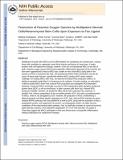Production of Reactive Oxygen Species by Multipotent Stromal Cells/Mesenchymal Stem Cells Upon Exposure to Fas Ligand
Author(s)
Rodrigues, Melanie; Turner, Omari; Stolz, Donna; Griffith, Linda G.; Wells, Alan
DownloadGriffith_Production of.pdf (4.854Mb)
OPEN_ACCESS_POLICY
Open Access Policy
Creative Commons Attribution-Noncommercial-Share Alike
Terms of use
Metadata
Show full item recordAbstract
Multipotent stromal cells (MSCs) can be differentiated into osteoblasts and chondrocytes, making these cells candidates to regenerate cranio-facial injuries and lesions in long bones. A major problem with cell replacement therapy, however, is the loss of transplanted MSCs at the site of graft. Reactive oxygen species (ROS) and nonspecific inflammation generated at the ischemic site have been hypothesized to lead to MSCs loss; studies in vitro show MSCs dying both in the presence of ROS or cytokines like FasL. We questioned whether MSCs themselves may be the source of these death inducers, specifically whether MSCs produce ROS under cytokine challenge. On treating MSCs with FasL, we observed increased ROS production within 2 h, leading to apoptotic death after 6 h of exposure to the cytokine. N-acetyl cysteine, an antioxidant, is able to protect MSCs from FasL-induced ROS production and subsequent ROS-dependent apoptosis, though the MSCs eventually succumb to ROS-independent death signaling. Epidermal growth factor (EGF), a cell survival factor, is able to protect cells from FasL-induced ROS production initially; however, the protective effect wanes with continued FasL exposure. In parallel, FasL induces upregulation of the uncoupling protein UCP2, the main uncoupling protein in MSCs, which is not abrogated by EGF; however, the production of ROS is followed by a delayed apoptotic cell death despite moderation by UCP2. FasL-induced ROS activates the stress-induced MAPK pathways JNK and p38MAPK as well as ERK, along with the activation of Bad, a proapoptotic protein, and suppression of survivin, an antiapoptotic protein; the latter two key modulators of the mitochondrial death pathway. FasL by itself also activates its canonical extrinsic death pathway noted by a time-dependent degradation of c-FLIP and activation of caspase 8. These data suggest that MSCs participate in their own demise due to nonspecific inflammation, holding implications for replacement therapies.
Date issued
2012-10Department
Massachusetts Institute of Technology. Department of Biological EngineeringJournal
Cell Transplantation
Publisher
Cognizant Communication Corp
Citation
Rodrigues, Melanie, Omari Turner, Donna Stolz, Linda G. Griffith, and Alan Wells. “Production of Reactive Oxygen Species by Multipotent Stromal Cells/Mesenchymal Stem Cells Upon Exposure to Fas Ligand.” Cell Transplantation 21, no. 10 (October 1, 2012): 2171–2187.
Version: Author's final manuscript
ISSN
09636897
15553892